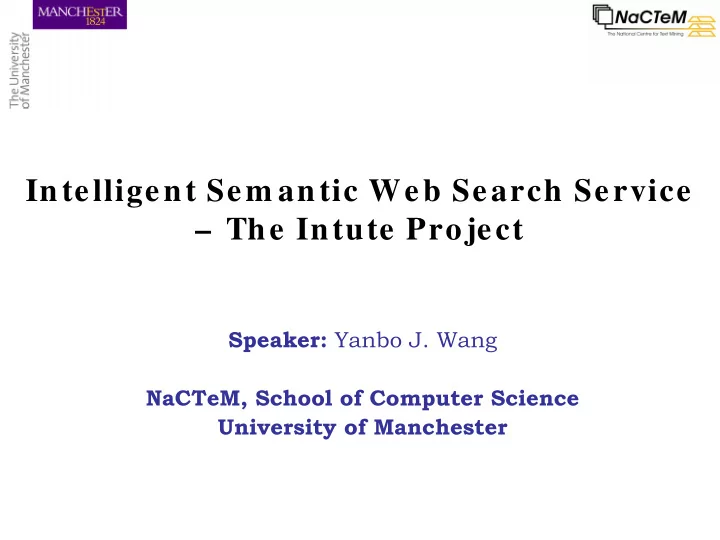

Intelligent Sem antic Web Search Service – The Intute Project Speaker: Yanbo J. Wang NaCTeM, School of Computer Science University of Manchester
Project Description The Intute project, co-funded by JISC (Joint Information Systems Committee) and AHRC (Arts and Humanities Research Council), is a joint work between NaCTeM, Mimas and the Intute Repository Search Project. The aim of the Intute project is to develop an intelligent semantic web search service using NaCTeM's text mining tools to grant users the benefit of advanced searching within an enhanced subset of the Intute repository, which harvests and aggregates metadata from UK-wide open repositories. One aspect for the Intute project is to employ the techniques of Text Classification (TC) ⎯ automated categorisation of “unseen” documents into pre-defined class-groups. 1
The Usage of TC in Intute The “ two-stage ” usage of TC techniques in the Intute project can be detailed as follows. Stage-one Usage: Single-label TC During the early stages of the Intute project, we are only focusing on those documents belonging to either Social Science or Bio-medical Science. However, documents in the Intute repository are not necessarily assigned to domain- classes. It is therefore an essential preliminary task to automatically and accurately distinguish these Social Science or Bio-medical Science documents from other documents in the collection. 2
Stage-one Usage of TC in Intute Social Science Documents Bio-medical Single-label Science Text Classifier Documents The “unseen” Intute Documents Others Fig. 1. Stage-one Usage of TC in Intute 3
Demo of Single-label TC – The TFPTC text mining software Classifier Type CARM – Classification based on Association Rule Mining Classifier Name TFPTC – Total From Partial Text Classification Document-base Reuters.D6643.C8 6 , 643 # of Documents # of Classes 8, {acq, crude, earn, grain, interest, money-fx, ship, trade} {2 , 108, 444, 2 , 736, 108, 216, 432, 174, 425} # of Doc. per Class Mutual Information Feature Selection 1 , 200 # of Key Words Support 0.1% 35% Confidence Training : Test 50 : 50 4
5 The Keyword-only Approach
6 Some Interesting Rules
7 The Phrase Approach
8 Some Interesting Rules
Stage-two Usage of TC in Intute Stage-two Usage: Multi-label TC Usually, a search result is presented as a (long) list of “matching” documents. Fig. 2 shows the result for querying “ fuel crisis ” on Google. There are total 1,320,000 records returned. Obviously, no one will read them all. Hence presenting this search result in groups, separated by different topics (sub-domain-classes) is suggested. Fig. 2. A Search Result from Google 9
Stage-two Usage of TC in Intute Broadly speaking, Social Science sub-branches include Anthropology, Economics, Education, Geography, History, Law, Linguistics, Political Science, Psychology, Social Work, Sociology, etc. Hence the search result of “ fuel crisis ” can be presented regarding these branch-classes (see Fig. 3 ). Note that a result document (record) may be associated with more than one branch-classes. Economics Political Science Geography Law Document # 1 Document # 2 Document # 1 Document # 5 Document # 3 Document # 5 Document # 6 Document # 21 Document # 5 Document # 8 Document # 21 … Document # 10 Document # 14 … … … Fig. 3. Presenting a Search Result in Classes 10
Strategy of Multi-label TC From the demo of Single-label TC, we see two rules as follows. Hence we indicate that a compound rule can be described as: {Advisors, Completes/ Completing} ⇒ {money-fx} 11
Strategy of Multi-label TC Also from the demo of Single-label TC, we see another two rules. Hence we indicate that a multi-labeled compound rule can be described as: {Advisors, Bonds/ Bond} ⇒ {money-fx, interest} 12
Further Development Fig. 4 shows the HASSET (Humanities and Social Science Electronic Thesaurus) categories. The HASSET categories can be used to present Social Science related documents in subject/domain hierarchies. We introduce an hierarchical multi- label TC problem to map new unlabeled documents to the HASSET hierarchy. This allows the user to concentrate on a “small” group of “interesting” results and offers a solution to the problem of information overload. Fig. 4. The HASSET Categories 13
Summary The Intute project aims to develop an intelligent semantic web search system that deals with Social Science and Bio-medical Science documents. Text classification is a well-known research area that maps documents to pre-defined categories. More than this, the techniques we use allow users to see why those predictions have been made. As work continues on the Intute project, we will be adding a number of other text mining tools to support cross-repository search focusing on areas of interest to social scientists. Questions? 14
Recommend
More recommend